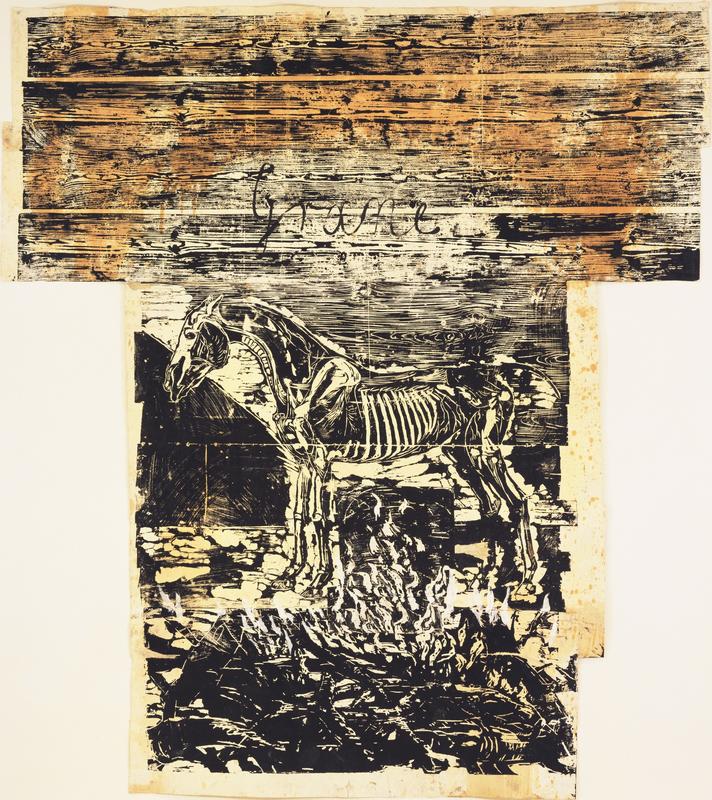More about Grane
- All
- Info
- Shop

Contributor
Grane by Anselm Kiefer is the depiction of the horse hero in Richard Wagner’s opera cycle, Der Ring des Nibelungen.
Grane’s owner is a woman by the name of Brünhilde. Brünhilde is a shieldmaiden (an immortal female warrior) from Norse mythology. She is very cool and powerful. Richard Wagner took the character and adapted her to fit his series, The Ring, which consists of four operas. In the first of the four operas, Brünhilde, the daughter of the lord of all gods, protects two mortals, Siegmund and Sieglinde from the guardian of marriages, Fricka. Siegmund and Sieglinde are brother and sister...but find this out a little too late. They have an affair while Sieglinde’s husband is away and Siegmund promises to help her escape her forced marriage. As the guardian of marriages (forced and otherwise), Fricka wants to punish Siegmund and Sieglinde for their adultery but Brünhilde protects them, even though her father told her not to. Brünhilde’s punishment for this is mortality, because apparently eventual death is the price to pay for helping a friend. Anyways, by this time Sieglinde is pregnant and Siegmund dies in a fight. Not the best ending...but it gets better.
Brünhilde is made mortal and put into a Sleeping Beauty-like sleep until a man can come and awaken her. Before she is put to sleep though, she asks her father to at least make it so that only a brave man can awaken her. He agrees and surrounds Brünhilde by a circle of fire that only the bravest hero can cross. Enter Siegfried, who may or may not be the love child of his mother/father/aunt/uncle, Siegmund and Sieglinde!
He is brave enough to cross the flame and he and Brünhilde fall in love. He gives Brünhilde a ring, (which is actually an all powerful, Lord of the Rings-like ring, which sports a curse that no one who owns it shall escape death) to commemorate their love. Meanwhile there are a brother and sister, Gunther and Gutrune, who want the ring for themselves. They give Siegfried a potion to make him forget Brünhilde. Gunther marries Brünhilde (again against her will) and Gutrune married Siegfried. Brünhilde, not knowing that Siegfried is under the effects of a potion, is furious and tells Gunther and Gutrune’s guard where Siegfried’s weak spot is. Corrupted by desire for the ring, the guard kills Siegfried. The rest of them fight over the ring resulting in Gunther’s death. But Brünhilde, being the mature one, decided to take the ring back to the Rhinemaidens, the women whose gold was stolen to make the ring in the first place. Brünhilde orders a funeral pyre for Siegfried, puts on the ring, and with her trusty horse Grane (pictured here) gets on the pyre of her true love, thus returning the ring to the Rhinemaidens and ridding the world of the cursed ring.
So now that you know the entire backstory, we can get into why Kiefer made this piece. He was a German and as a German was really into German history and mythology. Most of his work “serves as a metaphor for universal suffering, sacrifice, and destruction,” and he is really good at portraying the drama of it al. As you can see by the skeleton horse walking over flames on “the primeval scorched landscape” and the fact that the piece is shaped like a tombstone, Kiefer wasn’t subtle. This piece is also ginormous, standing at over 9 feet tall and 8 feet wide. This work also connects to the atrocities experienced during the second World War, a subject Kiefer was adamant about bringing to the table during a time when even speaking of Nazism was taboo, much less making art about it. But as I’m sure you can tell, Kiefer was not one to beat around the bush.
Sources
- "Anselm Kiefer. Grane. (1980-93) | Moma." The Museum of Modern Art. Web. 19 Apr. 2018.
- Schwarm, Betsy. "Der Ring Des Nibelungen | Music Dramas By Wagner." Encyclopedia Britannica. N.p., 2018. Web. 19 Apr. 2018.
- "The Ring Cycle: Synopsis | Opera Australia." Opera.org.au. Web. 19 Apr. 2018.













